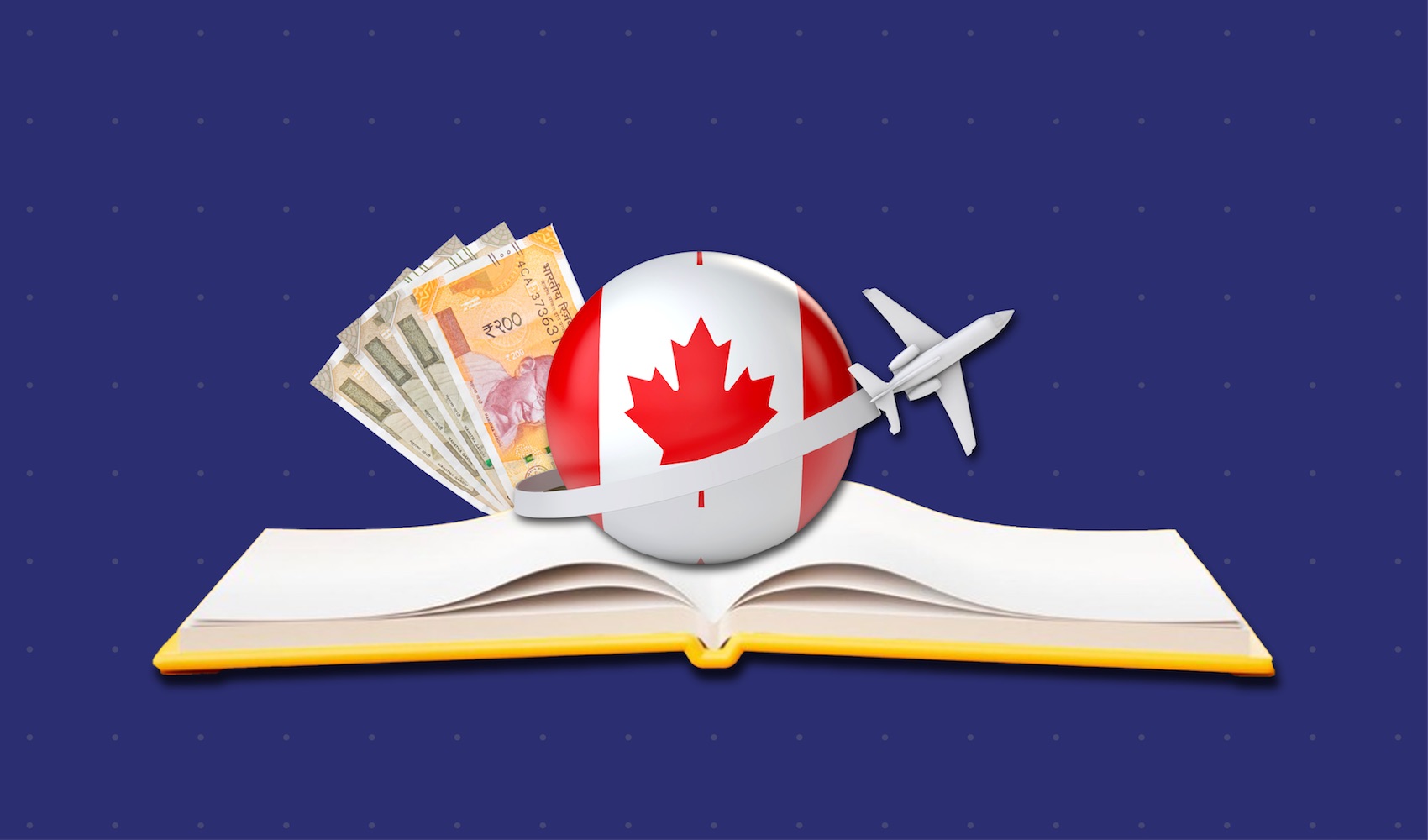Summary
- For eg, If you are located in the UK and applying for an Australian student visa from there, your application would be considered under the risk levels that are stipulated for India by DIBP (Department of Immigration and Border Protection).
- This category is basically for the students who are enrolled in a full-time higher education degree programme or course at a college/ university/ institute.
- If you have enrolled yourself in a registered VET (Vocational Education and Training) course in a TAFE or private institute, you will be applying for this subclass.
Before we move further, an overview of the student visa for Australia –
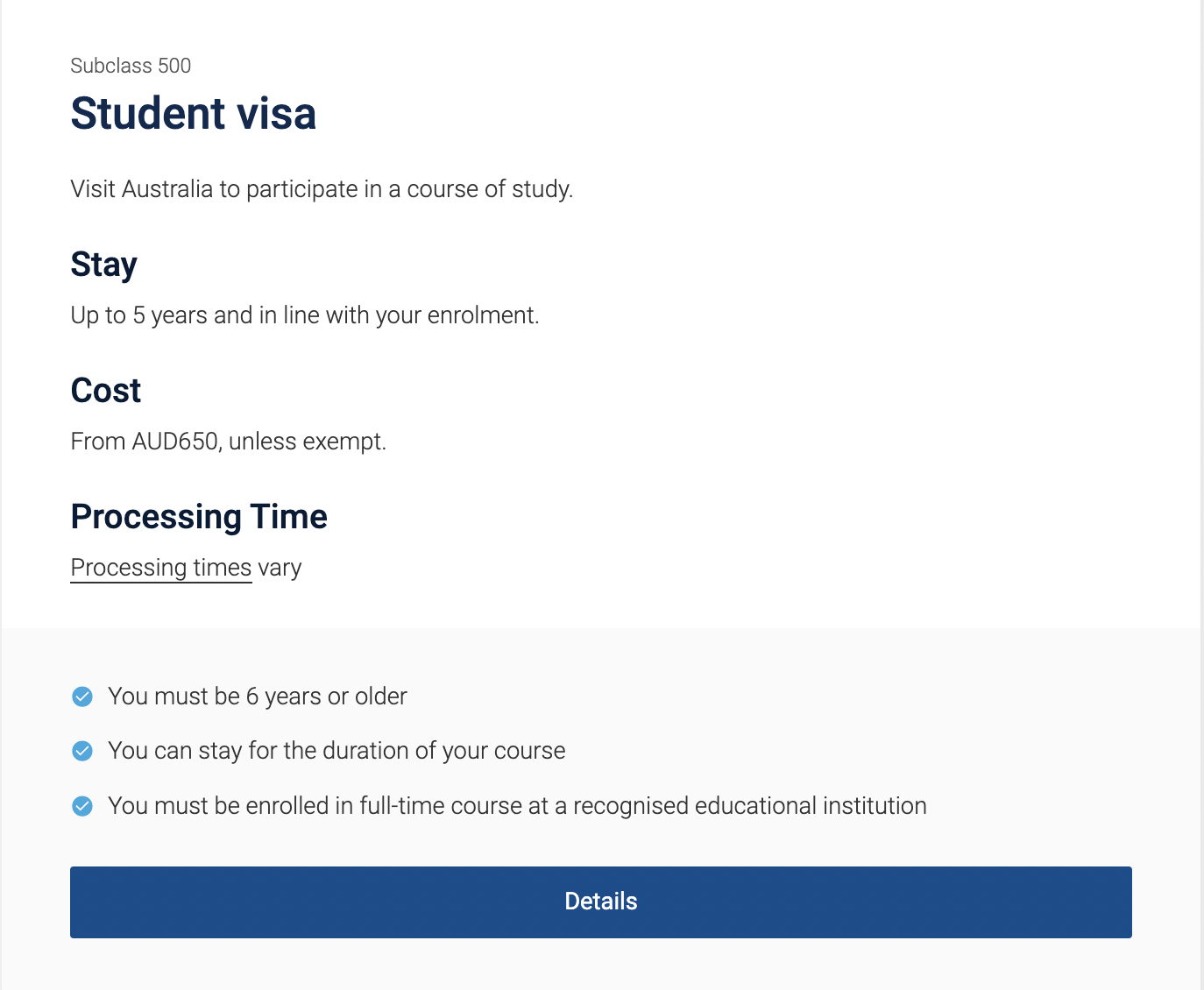
Now that you are looking into getting a student visa for Australia, there are many details that you must be aware of.
So, read the full piece below to find out what you for an Australian student visa.
This guide to your student visa for Australia includes –
- What is the Simplified Student Visa Framework (SSVF) for an Australian Student Visa?
- Student Visa for Australia (SubClass 500)
- Australian Student Visa Fees for Indian Students
- Student Visa for Australia – Eligibility Criteria
- Documents Needed for Student Visa for Australia
- How to Apply for an Australian Student Visa?
- Processing Time of Student Visa for Australia
- Validity of Student Visa for Australia
- FAQs on Student Visa for Australia
What is the Simplified Student Visa Framework (SSVF) for an Australian Student Visa?

As the name suggests, SSVF is a system to assess the student visa for Australia.
Earlier, the Australian student visas used to be categorised under Immigration Risk, according to which, some counties were put under an Assessment Level Framework.
But, with the new guidelines that came on 1st July 2016, the SSVF was introduced. According to this new system, the student visa processing guidelines now have an immigration risk and a new combined country framework. The paper applications for the old Assessment Level Framework have been discontinued, permanently.
Here’s how the SSVF is further categorised –
1. Nationality
- Your passport will determine your nationality.
- Your location at the time of applying for an Australian student visa will not be considered unless it matches the nationality mentioned on your passport.
- For eg, If you are located in the UK and applying for an Australian student visa from there, your application would be considered under the risk levels that are stipulated for India by DIBP (Department of Immigration and Border Protection).
2. Education Provider’s Risk of Default
- All Australian universities are put under different risk categories.
- Some are marked riskier than others.
- DIBP (Department of Immigration and Border Protection) has a tool, basis which, students are put under different risk categories.
- Your list of documents required for an Australian student visa will depend on the SSVF rule.
- You must keep all the documents handy as the DIBP can ask you to provide any document during your application.
Student Visa for Australia (SubClass 500)
Unlike earlier, if you wish to study in Australia, you will have to apply for an Australian student visa (Subclass 500).
This visa came into effect on 1st July 2016 and allows you to spend up to 5 years in Australia studying. This duration remains aligned with your enrolment date.
Scope of Your Subclass 500 Visa
- You can pursue a degree for up to 5 years in the country.
- You can pursue any desired study programme.
- A family member or a legal guardian can accompany you to the country.
- You can even apply in or outside the country through an online portal.
Various Eligible Streams/ Sectors for Australian Student Visa under Subclass 500
Here are the categories or streams that fall under student visa for Australia (Subclass 500). If your intended programme has relevance to any of the following streams, you will be required to produce an Australian student visa (subclass 500).
1. Independent ELICOS Sector
- You can apply for this visa if you’re travelling to Australia for a short-term course in the English language.
- The language course is called ELICOS – the English Language Intensive Course for Overseas Students.
- This course leads to a certificate I, II, III, or IV with varying durations.
2. Higher Education Sector
This category is basically for the students who are enrolled in a full-time higher education degree programme or course at a college/ university/ institute. Here are some courses that fall under this particular category –
- Courses at a UG level (Associate/ Bachelor Degree)
- Courses at a PG level (Master’s Degree like MS, MBA, etc)
- Postgraduate Diploma or Certificate courses like PDGBM, etc.
3. Vocational Education and Training Sector
If you have enrolled yourself in a registered VET (Vocational Education and Training) course in a TAFE or private institute, you will be applying for this subclass. This sector/ stream covers the following courses –
- Vocational Graduate Certificate
- Vocational Graduate Diploma
- VET Diploma
- Certificate I, II, III, and IV, except ELICOS
- VET Advanced Diploma
4. Postgraduate Research Sector
This category includes –
- Doctoral Degree Programmes
- Master’s Degree by Research
Australian Student Visa Fees for Indian Students
Your fees for a student visa for Australia will depend on –
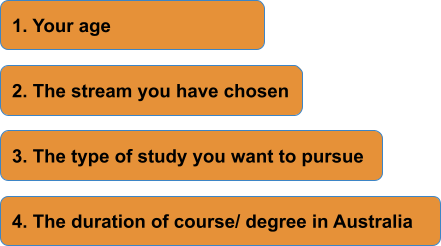
Based on these parameters, here is the processing fee for your Australian student visa.
| Visa Subclass | Base Application Charges | Additional Applicant Charges (if under 18 years) | Additional Applicant Charges (if 18 years or over) | Subsequent temporary application charge |
| Student visa (Subclass 500) (Subsequent Entrant) (6e) | AU$ 650 (₹ 35,974.78) | AU$ 160 (₹ 8,855.33) | AU$ 485 (₹ 26,842.72) | AU$ 700 (₹ 38,742.08) |
| Student visa (subclass 500) (6a, 6b, 6d) | AU$ 650 (₹ 35,974.78) | AU$ 160 (₹ 8,855.33) | AU$ 485 (₹ 26,842.72) | AU$ 700 (₹ 38,742.08) |
| Student Guardian (subclass 590) (6c, 6d) | AU$ 650 (₹ 35,974.78) | – | – | AU$ 700 (₹ 38,742.08) |
| Student visa (subclass 500) – Postgraduate research sector | AU$ 650 (₹ 35,974.78) | – | – | – |
| Student visa (subclass 500) – Foreign Affairs or Defence sector | – | – | – | – |
NOTE: The conversion of the Australian Dollar into INR is done when AU$1 = ₹55.35. The amount in INR is subject to change as per the market flow.
Student Visa for Australia – Eligibility Criteria
There is a long self-assessment that you must do before you apply to get a student visa for Australia. Check out the Australian student visa requirements and find out whether or not you should begin your application.
Academic Requirements to Get a Student Visa for Australia
- If you are going for a bachelor’s degree, you must have completed Class 12 or equivalent level of education with over 60% marks.
- If you are going for a master’s degree, you must hold a bachelor’s degree with at least 50% marks.
- As for backlogs during graduation, some universities accept 20 or more backlogs, whereas some recommend you to have less than 10.
NOTE: The university-specific requirements may vary. We recommend you go through the official admissions portal of the intended university before applying.
| Looking for a university that fits your requirements? Try SelectRight and choose what’s right for you! |
English Language Requirements to Get a Student Visa for Australia
Here are the different English language tests and minimum score requirements that you must meet to apply for an Australian student visa.
| English Language Test Providers | Minimum Score Required | Minimum Score Required for ELICOS (at least 10 weeks) | Minimum Score Required for ELICOS (at least 20 weeks) |
| IELTS | 5.5 | 5 | 4.5 |
| Cambridge English Advanced (Certificate in Advanced English) | 162 | 154 | 147 |
| TOEFL Internet-based Test | 46 | 35 | 32 |
| PTE Academic | 42 | 36 | 30 |
| Occupational English Test | B for each test component | – | – |
For exemptions, check below –
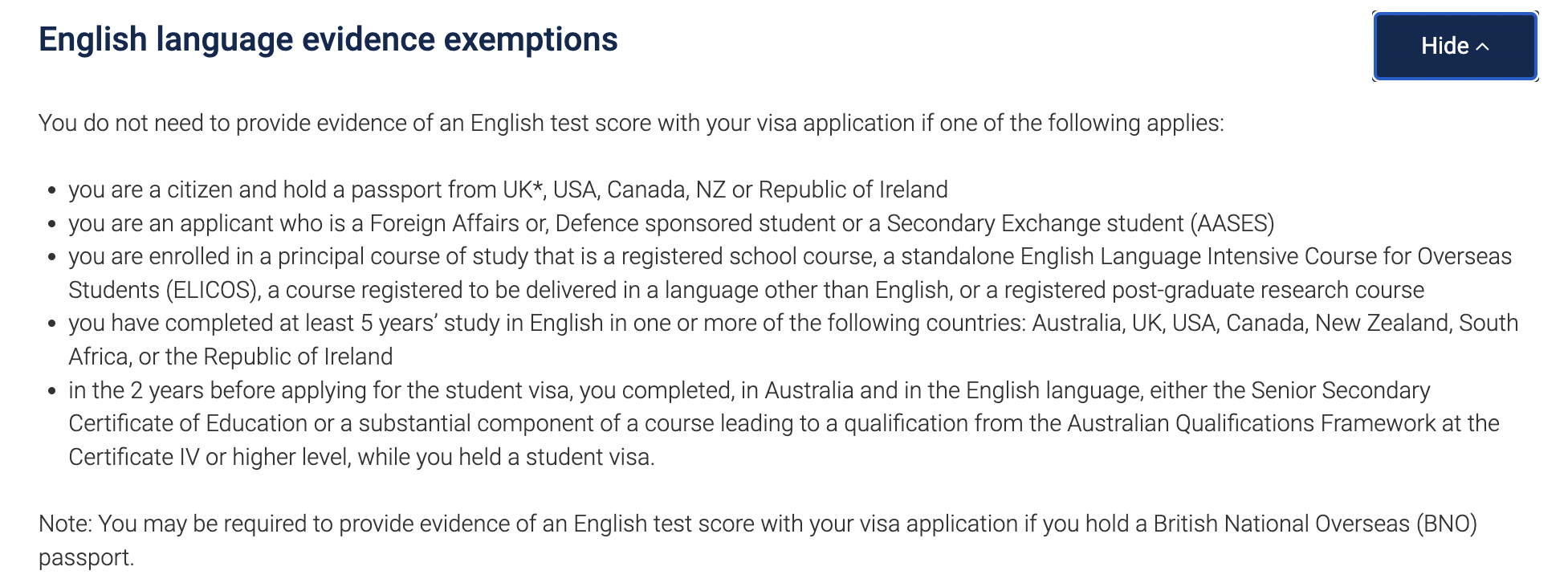
Financial Requirements to Get a Student Visa for Australia
To meet this requirement, you have to prove that you possess enough funds in your account to sponsor your living throughout the duration of your course. For this, you can provide your bank statements, an approved education loan certificate, scholarship or financial support, etc.
| Wondering which documents you need to meet the financial requirements? Click here! |
Documents Needed for Student Visa for Australia
Here are the important documents that you will have to produce to get a student visa for Australia –
- A valid passport
- Receipt for your visa application fee
- Proof of enrolment (show that you have been accepted to an Australian university)
- A GTE (Genuine Temporary Entrant) statement
- Documents proving your work experience, if required
- Academic transcripts
- English language proficiency certificates/ valid score cards
- Proof of fund
- An SOP (Statement of Purpose)
- Proof of your Overseas Student Health Cover/ health insurance policy
- Passport-sized photographs
- Parental consent (if you are under the age of 18 years)
Depending upon other factors, you may be required to provide more documents. Here are some study abroad documents that you must prepare before your application.
| Check Out: Official document checklist to get a student visa for Australia |
How to Apply for an Australian Student Visa?
The application to get a student visa for Australia majorly includes three steps –
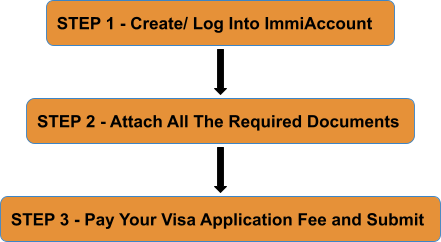
Now, let’s discuss them in detail –
STEP 1 –
- If you are a first-time user, you will have to first create an account on the official immigration portal of the Australian govt. – ImmiAccount.
- If you already have an account, you can simply log into the portal and begin filling out the application form.
| Apply for an Australian Student Visa Now! |
STEP 2 –
- Next step is to upload all the required documents.
- You can check out the list of documents needed for a student visa for Australia above.
STEP 3 –
- Finally, you have to pay the online application fee while keeping the exchange rates in mind.
- You can pay through Credit Card/ BPAY/ UnionPay/ PayPal.
| For more payment-related details, click here! |
Processing Time of Student Visa for Australia
After streamlining the entire processing time by introducing the Simplified Student Visa Framework (SSVF), the Australian student visa can be processed within a month.
However, certain streams may have a processing time of as long as 12 months!
Hence, it is important for you to begin your preparation in advance. Check out the table below to get more clarity on this.
NOTE: The following table discusses the processing time for an Australian student visa (Subclass 500) only.
| Streams | 50% of Application Processing Completed | 75% of Application Processing Completed | 90% of Application Processing Completed |
| Foreign Affairs or Defence Sector | 14 Days | 48 Days | 85 Days |
| Postgraduate Research Sector | 63 Days | 85 Days | 8 Months |
| Schools Sector | 29 Days | 70 Days | 4 Months |
| Independent ELICOS Sector | 29 Days | 44 Days | 78 Days |
| Non-Award Sector | 17 Days | 23 Days | 42 Days |
| Higher Education Sector | 29 Days | 57 Days | 7 Months |
| Vocational Education and Training Sector | 54 Days | 7 Months | 12 Months |
Validity of Student Visa for Australia
Earlier, before the introduction of Subclass 500, the Australian student visa would have remained valid for 5 years. But now, the validity of your visa depends on the duration of your course.
Check out the table to understand it better –
| Course Duration | Student Visa Validity |
| 10 months or less | Your visa will be rendered invalid one month after your course duration. |
| Over 10 months, when the course ends between January and October | Your visa will stay valid for two months after your course duration. |
| Over 10 months, when the course ends in November of December | Your visa will remain valid until 15th March of the following year. This means that if your course ends in November 2022, your visa will remain valid until 15th March 2023. |
Frequently Asked Questions on Student Visa for Australia
Question 1 – When should I apply for an Australian student visa?
Answer – You should apply to get a student visa for Australia at least two months before the commencement of your course. However, in some cases, the visa processing may take much longer. You must confirm the same from the official portal of Australian Immigration.
Question 2 – How much does a student visa for Australia cost?
Answer – The standard Australian student visa processing fee is AU$ 650 (₹ 35,974.78). This amount may include additional charges based on certain requirements.
Question – I am 17 years old. Can I also apply for an Australian student visa (subclass 500)?
Answer – As long as you meet other visa requirements, you can apply for subclass 500. However, you will be required to produce additional documents like a consent form from your parents.






